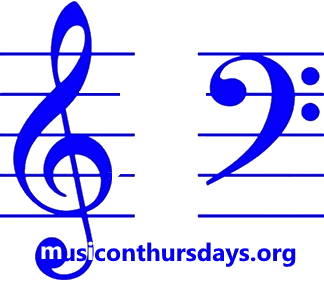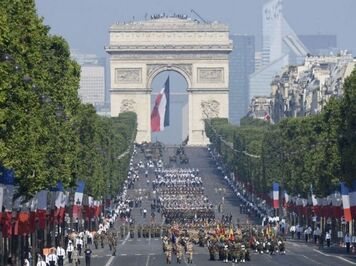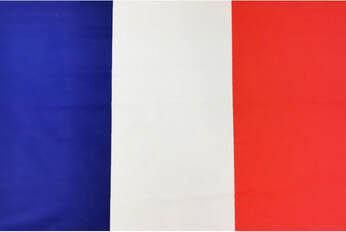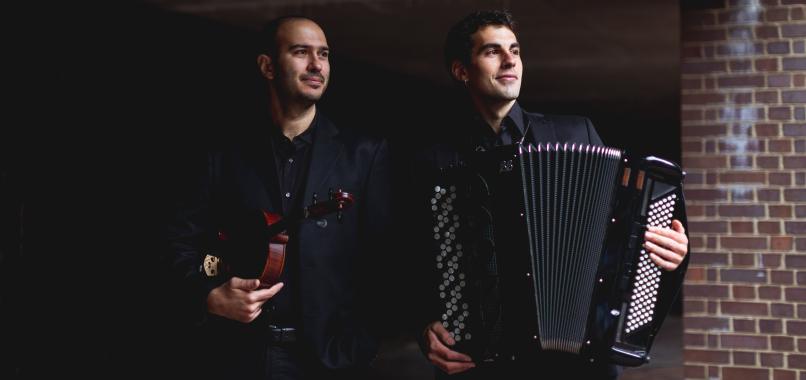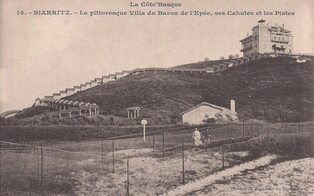|
|
Diphonon Duo
Michael Iskas, alto / viola
Iñigo Mikeleiz Berrade, accordéon
Programme
Marin Marais (1656-1728)
Couplets de folies (pub 1701)
selection des Theme & 31 variations
Joseph Maurice Ravel (1875-1937)
Pavane pour une Infante Défunte M19 (1899) Pavane for a Dead Princess
Gabriel Urbain Fauré (1845-1924)
Sicilienne Op 78 (1898)
Joaquín Taboada (b1960s)
El crecimiento de la hierba The grass grows
Achille Claude Debussy (1862-1918)
de Préludes, Livre 1
La fille aux cheveux de lin The girl with the flaxen hair (1909/10)
Graciane Finzi (b 10 juillet 1945, Casablanca)
Impression Tango (2005)
Chansons et Valses Françaises
Louis Charles Augustin Georges Trenet (1913-2001)
La Mer (1943, paroles: 1929, à l'âge de 16 ans)
Jean Hubert Peyronnin (1901-1948)
(on dit qu'il a acheté la mélodie du joueur de banjo Auguste "Gusti" Malha)
Reine de Musette Musette/Cabaret Queen
Vincent Scotto (1874-1852)
du film Clodoche Comic Dancer (1938)
Sous les Ponts de Paris 'Neath the Bridges of Paris
Yann Tiersen (b1970, Breton)
de la band snore du film Le Fabuleux Destin d'Amélie Poulain (2001)
La valse d' Amélie
Hubert Yves Adrian Giraud (1920-2016)
du film au même nom, de 1951
Sous le Ciel de Paris Beneath the Paris Sky
Chansons d'Édith Giovanna Gassion - dite Édith Piaf (1915-1963)
Angel Amato né Cabral (1911-1997)
Paroles: Michel Rivgauche né Mariano Georges Antoine Ruiz (1923-2005)
La Foule (1957) The Crowd
Norbert Glanzberg (1910-2001)
Paroles: Henri Contet (1904-1998)
Padam padam (1951)
"Louiguy", né Louis Guillaume Guglielmi (1916-1991)
Paroles: Édith Piaf
La Vie en Rose (1945)
Charles Dumont (né 1929)
Paroles: Michel Vaucaire (1904-1980)
Non, Je Ne Regrette Rien (1956)
ENCORE
Claude Joseph Rouget de Lisle (1760-1836)
La Marsellaise (1792)
Concert duration approx: 45+ minutes
Please donate to help fund these concerts at: cafdonate.cafonline.org/14455
Textes: La Marseillaise
|
Texte Original:
Allons enfants de la patrie, Le jour de gloire est arrivé ! Contre nous de la tyrannie, L’étendard sanglant est levé ! L’étendard sanglant est levé ! Entendez-vous dans les campagnes Mugir ces féroces soldats ? Qui viennent jusque dans nos bras Egorger nos fils et nos compagnes ! Aux armes citoyens ! Formez vos bataillons ! Marchons, marchons, Qu’un sang impur Abreuve nos sillons! |
English Singing Version:
Allon zonfon de la patr-i-i-e, Le jour de gloi-ray t'arrivay ! Contre noo de la tyrann-i-e, L’aytondar sanglon tay levay ! L’aytondar sanglon tay levay ! Ontonday-vous dons les com-paan-ye Muu-gir say fe-ro-sse sol-daa ? Qui vyenn-e juice-que dons nos bra ay-gor-ger no feess et nos compaan-ye ! 'ose arm-e ci-toy-on ! For-may vo ba-tie-yons ! Mar-shons, mar-shons, K’earn song am-puur Abrerv-e nos si-yon! |
|
English Translation
Arise, children of the Fatherland, The day of glory has arrived! Against us tyranny’s Bloody banner is raised, Bloody banner is raised. Do you hear, in the countryside, The roar of those ferocious soldiers? They’re coming right into your arms To cut the throats of your sons, your women! To arms, citizens, Form your battalions, Let’s march, let’s march! Let an impure blood Soak our fields! |
Diphonon Duo
Diphonon Duo is a viola and accordion duo formed by the Greek viola player Michael Iskas and Iñigo Mikeleiz Berrade, accordionist, from Navarra,Spain. Michael and Iñigo established this
ensemble in 2015 during their Masters of Arts studies at the Royal Academy of Music, after discovering common musical interests.
The Greek word "Diphonon" (Δίφωνον) refers to the quality of “having two voices”. The combination of accordion and viola, bow and bellows, is an unusual duo. However, the two instruments have many similarities, since both are able to sustain the sound and vary its colour and intensity.
The repertoire performed by Diphonon Duo reaches different styles and ages : from original works for the duo to transcriptions of baroque and classical music, involving the audience in a journey through time and space, travelling mus ically from the 17th century to the present day and visiting countries all over the world and their musical traditions.
As the repertoire for thi s combination of instruments is quite limited, Diphonon Duo often draws the attention of contemporary composers who collaborate with them. Some of this repertoire was recorded in their debut album Emerging Voices.
Diphonon Duo performs in various venues in London, across the UK and Spain such as the Wigmore Hall, St Martin-in-the-fields, St James's Piccadilly, Bristol Beacon, Seamus Heaney Home Place (Bellaghy, Northern Ireland), Civican Centre (Pamplona, Spain) and Teatro Cajasol (Seville, Spain).
They regularly collaborate in outreach projects with Wigmore Hall and the organisation Live Music Now. Working in this field is at the core of Diphonon Duo’s values and aims, since they believe that music has the power to break barriers and bring people together.
The duo has received coaching and guidance from eminent musicians such as Owen Murray, Mie Miki, Bjarke Mogensen, James Sleigh, Roger Chase and Garth Knox. This has shaped the ensemble's stylistic perception, enabling them to contribute to the unique character of each composition.
ensemble in 2015 during their Masters of Arts studies at the Royal Academy of Music, after discovering common musical interests.
The Greek word "Diphonon" (Δίφωνον) refers to the quality of “having two voices”. The combination of accordion and viola, bow and bellows, is an unusual duo. However, the two instruments have many similarities, since both are able to sustain the sound and vary its colour and intensity.
The repertoire performed by Diphonon Duo reaches different styles and ages : from original works for the duo to transcriptions of baroque and classical music, involving the audience in a journey through time and space, travelling mus ically from the 17th century to the present day and visiting countries all over the world and their musical traditions.
As the repertoire for thi s combination of instruments is quite limited, Diphonon Duo often draws the attention of contemporary composers who collaborate with them. Some of this repertoire was recorded in their debut album Emerging Voices.
Diphonon Duo performs in various venues in London, across the UK and Spain such as the Wigmore Hall, St Martin-in-the-fields, St James's Piccadilly, Bristol Beacon, Seamus Heaney Home Place (Bellaghy, Northern Ireland), Civican Centre (Pamplona, Spain) and Teatro Cajasol (Seville, Spain).
They regularly collaborate in outreach projects with Wigmore Hall and the organisation Live Music Now. Working in this field is at the core of Diphonon Duo’s values and aims, since they believe that music has the power to break barriers and bring people together.
The duo has received coaching and guidance from eminent musicians such as Owen Murray, Mie Miki, Bjarke Mogensen, James Sleigh, Roger Chase and Garth Knox. This has shaped the ensemble's stylistic perception, enabling them to contribute to the unique character of each composition.
Recordings of the works in today's concert
Marin Marais (1656-1728)
Couplets de folies (pub 1701)
sélection des Theme & 31 variations
The full title of this set of theme and variations is actually Couplets de folies d'Espagne. Let's overlook that point and listen to as much of the full set of variations as you choose in this recording by Hesperion XXI. They are Jordi Savall, viola da gamba, Luca Gulielmi, harpsichord, and Rolf Lisevand, theorbo.
Couplets de folies (pub 1701)
sélection des Theme & 31 variations
The full title of this set of theme and variations is actually Couplets de folies d'Espagne. Let's overlook that point and listen to as much of the full set of variations as you choose in this recording by Hesperion XXI. They are Jordi Savall, viola da gamba, Luca Gulielmi, harpsichord, and Rolf Lisevand, theorbo.
Joseph Maurice Ravel (1875-1937)
Pavane pour une Infante Défunte M19 (1899) Pavane for a Dead Princess
The Château d'Ilbarritz, in the French Basque country, sits high on its hill overlooking the town of Biaritz and the Atlantic Ocean. It has had a varied life since Baron Albert de L'Espée had his modern chateau built in the mid 1890s. He only lived there for the first four years, after that it became a First World War hospital, a casino. It could have been at the heart of a luxury estate of grand houses - but for funds running out as a result of the 1929 crash. Next a hotel, a convalescence home for refugees from the war in Spain, a German garrison from 1940, then a farm, a hotel again.
The Baron had an organ put into his chateau, the largest organ in a private house, at the time. It was built by the famous French organ-builder Cavaillé-Coll. We don't have to travel that far to hear it. After four years it went back to the workshops, and is now the organ in the Sacré-Cœur Basilica in Paris.
It was replaced in the chateau by an instrument built by one of Cavaillé-Coll's most successful former employees, Charles Mutin. This is the organ we are about to hear. It too is no longer in the chateau. It has made its way to the basilica-church in Usurbil, in the Spanish Basque country, near San Sebastian.
Our second reference to Spain, in a French concert? Let's keep an eye on that border.
The organist in Usurbil is the basilica's head organist Loreto Aramendi:
Pavane pour une Infante Défunte M19 (1899) Pavane for a Dead Princess
The Château d'Ilbarritz, in the French Basque country, sits high on its hill overlooking the town of Biaritz and the Atlantic Ocean. It has had a varied life since Baron Albert de L'Espée had his modern chateau built in the mid 1890s. He only lived there for the first four years, after that it became a First World War hospital, a casino. It could have been at the heart of a luxury estate of grand houses - but for funds running out as a result of the 1929 crash. Next a hotel, a convalescence home for refugees from the war in Spain, a German garrison from 1940, then a farm, a hotel again.
The Baron had an organ put into his chateau, the largest organ in a private house, at the time. It was built by the famous French organ-builder Cavaillé-Coll. We don't have to travel that far to hear it. After four years it went back to the workshops, and is now the organ in the Sacré-Cœur Basilica in Paris.
It was replaced in the chateau by an instrument built by one of Cavaillé-Coll's most successful former employees, Charles Mutin. This is the organ we are about to hear. It too is no longer in the chateau. It has made its way to the basilica-church in Usurbil, in the Spanish Basque country, near San Sebastian.
Our second reference to Spain, in a French concert? Let's keep an eye on that border.
The organist in Usurbil is the basilica's head organist Loreto Aramendi:
Gabriel Urbain Fauré (1845-1924)
Sicilienne Op 78 (1898)
Here is an all-French performance by cellist David Louwerse and pianist François Daudet. Sicilienne? That's admissible today as it is a Sicilian dance form used by many European composers, and Fauré was, after all, Head of the Paris Conservatoire.
Joaquín Taboada (né 1960s)
El crecimiento de la hierba The grass grows
Spanish title, Spanish composer. Iñigo and Michael assure us the piece is evocative of France.
See what you think of the Joaquin Taboada Duo. The cellist is Igor Sáenz.
El crecimiento de la hierba The grass grows
Spanish title, Spanish composer. Iñigo and Michael assure us the piece is evocative of France.
See what you think of the Joaquin Taboada Duo. The cellist is Igor Sáenz.
Achille Claude Debussy (1862-1918)
de Préludes, Livre 1
La fille aux cheveux de lin The girl with the flaxen hair (1909/10)
Here is a beautiful arrangement for "accordion orchestra" written by John Holvast, Director of Accordion Orchestra AVAZ, of Arnhem, Netherlands. He is the conductor you will see in this video:
de Préludes, Livre 1
La fille aux cheveux de lin The girl with the flaxen hair (1909/10)
Here is a beautiful arrangement for "accordion orchestra" written by John Holvast, Director of Accordion Orchestra AVAZ, of Arnhem, Netherlands. He is the conductor you will see in this video:
Graciane Finzi (né 10 juillet 1945, Casablanca) [6:42]
Impression Tango (2005)
We may not know much about the music of Graciane Finzi (no relation to Gerald), but the performers here are fairly familiar to us. At the Royal Academy, in 2016 they are Diphonon Duo:
Impression Tango (2005)
We may not know much about the music of Graciane Finzi (no relation to Gerald), but the performers here are fairly familiar to us. At the Royal Academy, in 2016 they are Diphonon Duo:
Louis Charles Augustin Georges Trenet (1913-2001)
La Mer (1943, Paroles: 1929, à l'âge de 16 ans)
Here is Charles Trenet with his usual accompanists, Raymond Lefebvre et son Grand Orchestre, Raymond himself at the piano:
La Mer (1943, Paroles: 1929, à l'âge de 16 ans)
Here is Charles Trenet with his usual accompanists, Raymond Lefebvre et son Grand Orchestre, Raymond himself at the piano:
Jean Hubert Peyronnin (1901-1948)
Reine de Musette Musette/Cabaret Queen
We can probably forgive the mistakes in this remarkable performance of a tricky-looking piece of music.
Karène Neuville was 11 years old when this was recorded in 2012:
Reine de Musette Musette/Cabaret Queen
We can probably forgive the mistakes in this remarkable performance of a tricky-looking piece of music.
Karène Neuville was 11 years old when this was recorded in 2012:
Vincent Scotto (1874-1852)
du film Clodoche Comic Dancer (1938)
Sous les Ponts de Paris 'Neath the Bridges of Paris
Alexander and Sergey, The Borodin Brothers, both accordionists, play in front of a screen showing views of Paris:
du film Clodoche Comic Dancer (1938)
Sous les Ponts de Paris 'Neath the Bridges of Paris
Alexander and Sergey, The Borodin Brothers, both accordionists, play in front of a screen showing views of Paris:
Yann Tiersen (b1970, Breton)
de la bande sonore du film Le Fabuleux Destin d'Amélie Poulain (2001)
La valse d' Amélie
This piano performance is by Lang Lang, at the Greene Room, near Hudson Square, Lower Manhattan. That is the home of New York Public Radio stations WNYC and WQXR which broadcast classical music to New York, New Jersey and New Hampshire.
de la bande sonore du film Le Fabuleux Destin d'Amélie Poulain (2001)
La valse d' Amélie
This piano performance is by Lang Lang, at the Greene Room, near Hudson Square, Lower Manhattan. That is the home of New York Public Radio stations WNYC and WQXR which broadcast classical music to New York, New Jersey and New Hampshire.
Hubert Yves Adrian Giraud (1920-2016) [
du film au même nom de 1951
Sous le Ciel de Paris Beneath the Paris Sky
We know nothing about Weitao Ren, except that he has a lovely style on the piano accordion.
If you are missing the words, though, have a listen to the Choeur de la Légion Étrangère:
du film au même nom de 1951
Sous le Ciel de Paris Beneath the Paris Sky
We know nothing about Weitao Ren, except that he has a lovely style on the piano accordion.
If you are missing the words, though, have a listen to the Choeur de la Légion Étrangère:
|
|
|
Chansons d'Édith Giovanna Gassion
dite Édith Piaf (1915-1963)
Angel Amato né Cabral (1911-1997)
Paroles: Michel Rivgauche né Mariano Georges Antoine Ruiz (1923-2005)
La Foule (1957) The Crowd
In 1936 Argentinian guitarist and composer Angel Amato wrote the original song Que nadie sepa mi sufrir (Let no one know my suffering) or Amor de is amores (Love of my loves), based on a Peruvian dance rhythm. The prolific French lyricist Michel Rivgauche heard the song at the Teatro Ópera, Buenos Aires, in the same year and asked the composer for a French version.
Here is Edith Piaf, with English subtitles added. One comment points out that Piaf (slang for sparrow) rarely moved on stage so we are fortunate to have this wonderful exception:
Paroles: Michel Rivgauche né Mariano Georges Antoine Ruiz (1923-2005)
La Foule (1957) The Crowd
In 1936 Argentinian guitarist and composer Angel Amato wrote the original song Que nadie sepa mi sufrir (Let no one know my suffering) or Amor de is amores (Love of my loves), based on a Peruvian dance rhythm. The prolific French lyricist Michel Rivgauche heard the song at the Teatro Ópera, Buenos Aires, in the same year and asked the composer for a French version.
Here is Edith Piaf, with English subtitles added. One comment points out that Piaf (slang for sparrow) rarely moved on stage so we are fortunate to have this wonderful exception:
Norbert Glanzberg (1910-2001)
Paroles: Henri Contet (1904-1998)
Padam padam (1951)
Henri Contet qualified as an engineer in 1923. It was not until meeting Piaf during World War 2 that his song-writing career took off. In over 1,000 songs, he wrote 32 for Édith, with Padam, Padam probably the most famous. French wikipedia tells us that Glanzberg was born in the Polish town of Rohatyn "now in Ukraine." We can only hope it stays that way.
Here is Piaf telling us how a melody reminds her of a former lover. Recorded with the Robert Chauvigny orchestra.
Paroles: Henri Contet (1904-1998)
Padam padam (1951)
Henri Contet qualified as an engineer in 1923. It was not until meeting Piaf during World War 2 that his song-writing career took off. In over 1,000 songs, he wrote 32 for Édith, with Padam, Padam probably the most famous. French wikipedia tells us that Glanzberg was born in the Polish town of Rohatyn "now in Ukraine." We can only hope it stays that way.
Here is Piaf telling us how a melody reminds her of a former lover. Recorded with the Robert Chauvigny orchestra.
"Louiguy", né Louis Guillaume Guglielmi (1916-1991)
Paroles: Édith Piaf
La Vie en Rose (1945)
While Édith was an accredited lyricist, she was not a composer. Pianist and composer Louiguy recalls that the song was "born" on 12th October 1944, the day of his daughter Jeanne's christening, at which Édith was a godmother. Two months after the Liberation from German occupation, this was a lively, optimistic time in Paris.
The song went through several stages of development with Piaf and various close friends, until she brought the ideas and the words to her pianist, Louiguy. Many have sung the original words over the decades, and some have translated it into their own language. Gracie Fields, for example, made the melody famous as Take me to your heart again when she returned to Britain from Canada in 1946. Let's listen to both of these fabulous singers:
Paroles: Édith Piaf
La Vie en Rose (1945)
While Édith was an accredited lyricist, she was not a composer. Pianist and composer Louiguy recalls that the song was "born" on 12th October 1944, the day of his daughter Jeanne's christening, at which Édith was a godmother. Two months after the Liberation from German occupation, this was a lively, optimistic time in Paris.
The song went through several stages of development with Piaf and various close friends, until she brought the ideas and the words to her pianist, Louiguy. Many have sung the original words over the decades, and some have translated it into their own language. Gracie Fields, for example, made the melody famous as Take me to your heart again when she returned to Britain from Canada in 1946. Let's listen to both of these fabulous singers:
|
|
|
Charles Dumont (né 1929)
Paroles: Michel Vaucaire (1904-1980)
Non, Je Ne Regrette Rien (1956)
Dumont and Vaucaire worked closely together for many years, producing hundreds of songs. The connection is not always obvious because Dumont worked under several pseudonyms! Although the duo wrote the song in 1956, it was 1960 before Piaf recorded it. With the Algerian crisis at its peak at the time of the recording, Piaf dedicated it to the Légion Étrangère, who were fighting there. They have kept it as one of their special songs ever since. It was also taken up by the partisans of French Algeria.
When she first heard Anne Chapelle sing this song by Anne Chappelle, Édith Piaf apparently said, and repeated to friends often "C'est moi! C'est ma vie!" It's me, it's my life.
Paroles: Michel Vaucaire (1904-1980)
Non, Je Ne Regrette Rien (1956)
Dumont and Vaucaire worked closely together for many years, producing hundreds of songs. The connection is not always obvious because Dumont worked under several pseudonyms! Although the duo wrote the song in 1956, it was 1960 before Piaf recorded it. With the Algerian crisis at its peak at the time of the recording, Piaf dedicated it to the Légion Étrangère, who were fighting there. They have kept it as one of their special songs ever since. It was also taken up by the partisans of French Algeria.
When she first heard Anne Chapelle sing this song by Anne Chappelle, Édith Piaf apparently said, and repeated to friends often "C'est moi! C'est ma vie!" It's me, it's my life.
ENCORE
Claude Joseph Rouget de Lisle (1760-1836)
La Marsellaise (1792) (orchestration and fanfares by Hector Berlioz)
This is the official long version of La Marseillaise. At the concert, we will sing just the well-known first verse and two choruses! That means you can stop the recording at the 1 minute 55 second point in this recording of Hector Berlioz's orchestral arrangement if you wish.
Do they still play this at the end of French radio broadcasting each night?
Claude Joseph Rouget de Lisle (1760-1836)
La Marsellaise (1792) (orchestration and fanfares by Hector Berlioz)
This is the official long version of La Marseillaise. At the concert, we will sing just the well-known first verse and two choruses! That means you can stop the recording at the 1 minute 55 second point in this recording of Hector Berlioz's orchestral arrangement if you wish.
Do they still play this at the end of French radio broadcasting each night?
If you have TV5 as one of the international options on your TV contract, you will be able to follow events in Paris from around 10am UK time on Thursday 14th July.
TV5 is the equivalent of BBC World Service TV.
Of course, we would much prefer that you join us at Leatherhead Methodist Church, in Church Road, for our celebration concert.
Our thanks must go to Michael Iskas and Iñigo Mikeleiz for researching and putting together this excellent programme of music.
Previous concert
LEVANTO: flute, clarinet, bassoon - click here
Next Thursday's concert
Sungbin Cho, classical guitar, from the RAM - click here
